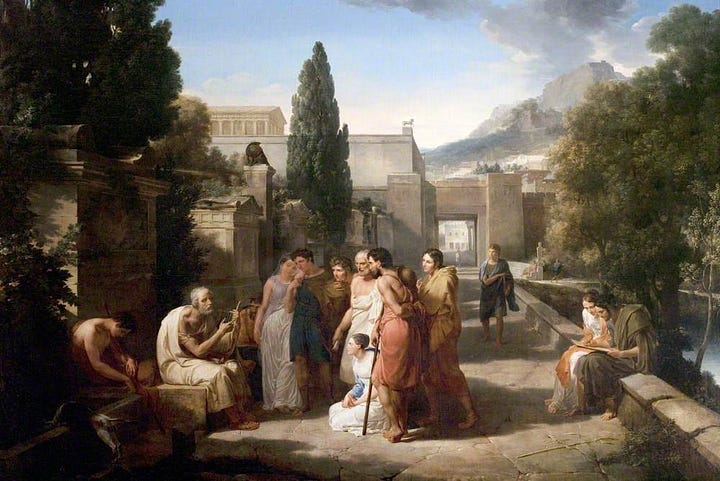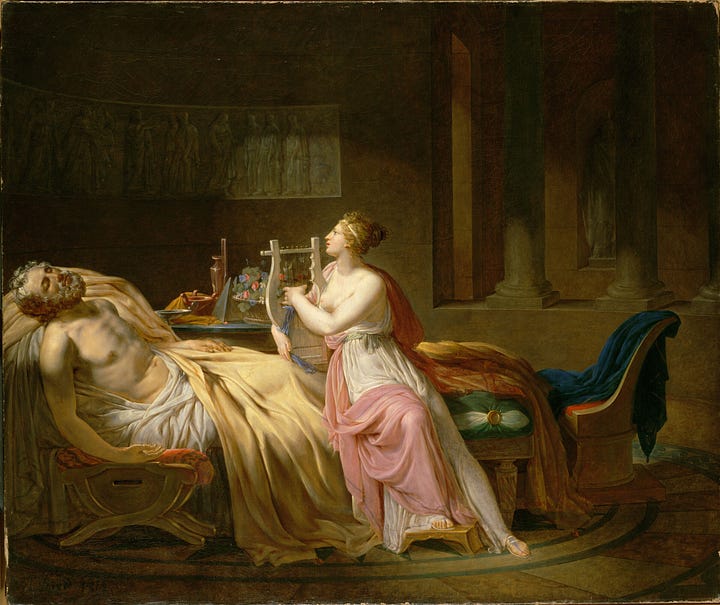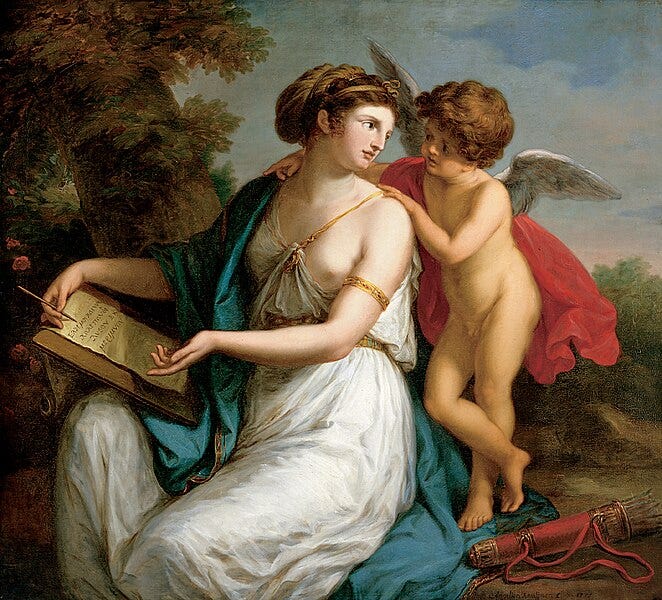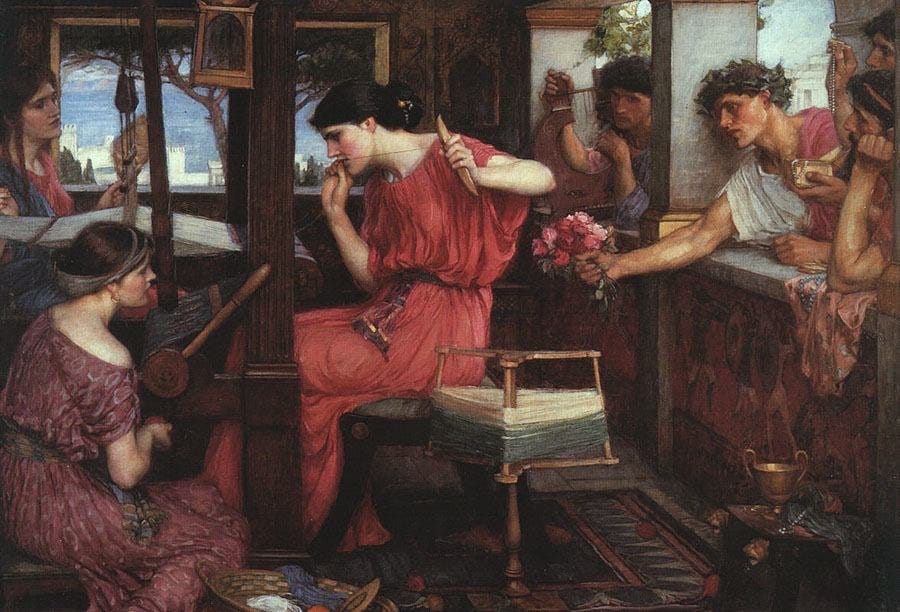Weaving with Sappho
poetry and music; two sides of a coin
So my new song Cruel Love is out on Bandcamp, it’s the eve of Spring where I live, and all that’s got me reminiscing…
Back when I was in university, working on my BA in English Literature, I was lucky enough to take a few classes taught by the amazing poet and literary translator Luci Collin, and one of those was a 6-month course on Ulysses, the novel by James Joyce.
I’ll never forget the first lesson of that course. To introduce the topic, Luci gave us a brief history of the Odyssey, the ancient Greek epic by Homer that was reimagined by the Irish author in his famous tome.
She began the lesson by describing the ancient world that engendered Homer’s narrative. (Disclaimer! I won’t get into the whole “who even was this Homer character?” dispute today, thank you.)
She spoke of a time when poetry was made to be sung, experienced as live performance. A time when poetry and music were sides of the same coin…
As she painted a word picture of the sheer magic exerted by such performances, I felt like I was transported to the streets of ancient Athens.
I could almost hear the sound of the strings, and when I closed my eyes, I could see Homer playing his lyre as an awestruck crowd formed around him, eager to learn the misfortunes of the clever Odysseus in his 20-year journey home from the Trojan war.


Luci compared the strange magnetism of that display to the mystical allure of an open fire. She stated that if one were to place an animal (e.g. a chicken) in front a bonfire, it would undoubtedly stare at it. The same behavior could be observed if the animal was replaced with a human being: they too would stare into the flames, in spite of themselves.
The notion that poetry/music being performed holds the same ensnaring power as a glowing flame has stayed with me all these years. It’s not an implausible concept, either. Just pay attention to the hypnotized crowd at a Chappell Roan concert and you’ll see what my college professor was talking about.
In case my mention of Chappell Roan has you wondering, Luci Collin did fiercely defend that writing music lyrics is no lesser of an art than producing a volume of poetry, an idea which several other members of academia seem to have a problem with. Hence the controversy around Bob Dylan being awarded the Nobel Prize in Literature in 2016…
Also, I love Luci (sorry, I had to!) so much for using a chicken to exemplify her point, specially where she’s comparing its behavior to that of a human being. Shoutout to Diogenes: “Here is Plato’s man!” But I digress.
There’s another genius from ancient Greece whose writing and lyre playing skills were akin to those of Homer: the woman who basically invented lyric poetry, the ultimate precursor to the sadgirl aesthetic, the lady loving rockstar from the island of Lesbos. Yes, you guessed it, Sappho!
Sappho, according to herself, was not concerned with recounting epic feats of war and heroism (as Homer had been). Her preferred subject matter, and main concern, was love. A card-carrying devotee of the goddess Aphrodite and her son Eros, Sappho spent her days writing and performing poetry, as well as teaching young women the arts of dance, music, poetry… and love.
From Sappho we’ve inherited the term lesbian, as she was known to have had romantic relationships with several of her pupils.
Sadly, apart from this one complete poem, nothing but fragments of her poetry still remain, some of which have only reached us because they’d been quoted in surviving texts by other authors.
Her fragments, however few, are most certainly ablaze and worth staring at.
In my case, I couldn’t just passively enjoy those embers… I had to weave with them.
Let me explain. A couple years ago, my friend, collaborator and bandmate, the multimedia artist Paul Conneally introduced me to the idea of “warp and weft”. This is my personal interpretation of his concept:
Think of the creative process as equivalent to the art of making fabric. “Warp” and “weft” are the basic components of weaving thread.
The warp (a set of yarns stretched on a loom) represents our references, the things that inspire us, the history, the artists and the art that have come before us. Whereas the weft (the fibre that gets threaded through the warp) represents our personal experiences, our unique views, and our inner worlds.
Much like Penelope of Ithaca, an artist can create the tapestry of their work by intertwining those two components into their own panorama of both wonderful and dreadful scenes.
Could it be that what James Joyce was doing with the Odyssey in his novel Ulysses was a case of the old warp and weft? I’d like to think so, as Odysseus and Leopold Bloom now strike me as irrevocably woven together in the forever unfinished cloth of human narrative.
The first time I felt the impulse to weave with Sappho was when I received a book of her fragments as a gift back in college.
As I wafted through the pages, I felt a peculiar sense of belonging, as if I was always meant to learn about that woman who lived and died all those centuries ago (though the biographical data is foggy, Sappho was probably born around 610 BCE).
Here’s a fragment by the Lesbian poet that I’ve recently added to my personal loom:
As a wind in the mountains
assaults an oak,
Love shook my breast.
(translated by Julia Dubnoff)
And here are the lyrics to Cruel Love:
You vex my heart
With unforeseen assault
Like a storm wind
Spreading bitter fire
You bend your bow
To trickery and sport
Sowing frenzy
With the poison of your dart
As the breath of the mountains
Shakes the leaves off the oak tree
So your maddening vortex
Shook the wisdom out of me
Oh, villainous darling
How you've led me astray
Oh savage, brutal hunter
While I breathe I'll sing your praise
If you happen to listen to the song, I hope you think of Sappho and of how she felt overwhelmed and bewildered by the mystery of Love throughout her life— as have I, and as most of us have felt before.
The narrative never ends. The tapestry just gets bigger and bigger.
May its flickering warmth keep the vile suitors ever away.
Thank you so much for reading ♡
Have an amazing Friday!
Love,
Venus Aphrodite ♀
List of paintings shown above:
1- Homer Singing His Iliad at the Gate of Athens, Guillaume Lethière (c.1814);
2- Calliope Mourning Homer, Jacques-Louis David (1812);
3- Sappho Inspired by Love, Angelica Kauffmann (1775);
4- Penelope and the Suitors, John William Waterhouse (1912).




I love that you’re so into poetry tho 💕
Okay this songggg >>>>> Love the weaving idea for art making. It’s crazy how the substack algorithm works, I just explored this idea in my most recent post as well!! It feels so accurate for writing and poetry to me